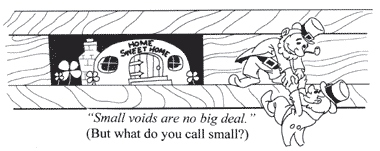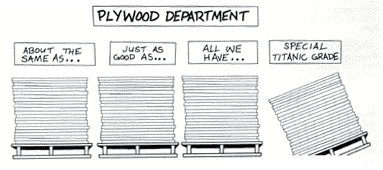Do not run your hand along the edge
of the plywood and other things you need to know about this
stuff
by Jim Betts
"Plywood," says one boat builder,
"is just a bunch of splinters glued together." Well,
that is so, but it gets more complicated because plywood is
a lot of information not stuck together and some degree of
research is needed. Let's get a few basics out of the way
and then go into a broader look:
1. No matter what it says on the sheet of plywood,
anyone with a rubber stamp can label the material anything
they want. Yes, there is counterfeit plywood. IABBS has been
asked about "Boat Grade" or "Boat Building
Grade." The American Plywood Association (APA) says there
is no such thing.
2. Graded plywood varies from manufacturer to
manufacturer. So AA grade (the best), may look super, or semi-super,
or below-super, or just not super at all, but more like trash.
There is no industry law about this, only the APA's standards,
which are voluntary. Plywood is made in the U.S. and many
other countries and they each have their own way of labeling
any products.
3. Yes, Marine Grade and Exterior use the same
waterproof glue. The main difference is that Marine has solid
inner plies where Exterior can have voids. This is especially
important when the plywood is bent, because the voids will
give a weak area that will not bend in a uniform manner. (Quite
frankly, I am tempted to sum up this story with USE MARINE
GRADE! But that's too simple.) But look at the economics:
If you are building a boat that will cost $5,000 all-up (materials,
motor, sails, etc.) and you use 10 sheets of plywood - where
3/8 in. Exterior is about $20 a sheet and where Marine is
about $40 - you have a difference of $200 for the whole boat.
This is only 4% of the total cost of the boat. For $200 you
will sleep better - especially if you are on the boat!

4. Plywood is sold under a number of names of
the wood used; Fir, Mahogany, etc. Then there is Luan, which
is about the same as Okoume (o-KU-me), both of which are really
Philippine Mahogany, which is not Mahogany at all, but Cedar.
(Often called cigar-box Cedar because it is used for that.)
Fir is the strongest and Luan is well below that.
5. A major problem with plywood is checking.
This is because it is made up of hard and soft wood. They
do not hold together well and tend to separate. Fiberglass
(FRP) is often used to cover the plywood in order to prevent
this, or at least to hide it. 6. Some plywood boats are designed
to be "encapsulated." That is to say, the plywood
is coated both sides and edges with epoxy with or without
the FRP. This gives a watertight coating. However, if it develops
a leak, it also keeps the water in. This is where rot starts.
But in general such encapsulation is in wide use and some
designers specify it in their plans.
7. Then there is MDO (Medium Density Overlay)
plywood. This is coated on one or both sides with a plastic
sort of material that looks much like the brown paper used
in grocery bags. It gives a smooth surface and is ready to
paint. It costs more than Exterior, but less than Marine and
certainly less than the cost of FRP treatment. The big problem
here is that few suppliers carry this, so you will have to
have it shipped. Harbor Sales Co. is the major source.
8. Plywood is heavy. It is 34 pounds per cubic
footand Fir lumber is 32 and Cedar is 21. A 4x8 sheet of 3/8
plywood weighs 35 pounds and one-inch is 96. And a 4x8 sheet
is hard to handle, especially outdoors with the wind blowing!
This is one reason for plywood lapstrake designs - narrow
pieces are easy to handle.
9. The number of plies (layers) is important.
The 3/8 stuff you get at the local lumber yard mostly has
three plies, two fairly thin outer plies and one fairly thick
inner ply. This is usually soft wood. Use a pencil point or
a nail to test it. Try to find five-ply in 3/8 and 1/2, and
seven-ply in 5/8 and 3/4 and go for nine-ply in one-inch plywood.
10. This will outweigh points I through 9. Sad
to say, the major factor is "What you can get."
Or what your local lumber yard has. Sure, you can get anything
from anywhere, if you pay the price. (But do go back to point
3 and note the cost as a percentage of your total cost. And
consider solid lumber, which is much cheaper.) Plywood from
out of town comes by truck. For the most part, they will not
deliver to a residential address. So you will have to have
it come to a business with a loading dock, or have it delivered
to a local lumber yard that will then deliver to you. (Even
amateur-built boats are expensive!)
II. Do think about other materials. Plywood
was very new and exciting back in the 1930s. There are other
materials and methods - cold molded veneer (make your own
plywood to the shape you want — see story on this in the June
issue). And "real wood," which is cheaper and readily
available. Boats were made of solid wood long before plywood
and FRP and metal. Yes, real wood does not come in the thickness
you may want, so have it cut to your specs. Local lumber yards
and woodworking shops have planning mills for doing this.
And fiber-glass is easier than you think. (See story on C-flex
in this issue.)

Let's wrap this up before you go to sleep
Yes, you can say only so much about plywood
or most anything else. It is a great material. It is used
for boats, airplanes, houses, hog-feeding troughs and much
more. But it is FLAT. The main trouble with plywood boats
is that they look like plywood boats. No sexy classic curves,
no varnished Mahogany, no subtle shapes. Designers have often
bowed to the demands (read LIMITS) of plywood.
But plywood is strong, easily cut and relatively
cheap. A plywood boat is better than no boat at all.
Plywood has made amateur boat building the popular
hobby that it is. It is indeed "engineered wood,"
but other materials and methods should be looked at. And what
new material is in the future? Will we be able to grow a boat
the way we now grow watermelons? Hey, a 40-foot watermelon,
cut in half, with a tough skin, is interesting. And think
of all the eating pleasure as you hollow it out!
U.S. SUPPLIERS OF MARINE PLYWOOD
(Hint - Check your local yellow pages and/or
call the boat manufacturers and repairers in your area and
ask them where they get their plywood.)
Harbor Sales Co., 1000 Harbor Court, Sudlersville
MD 21668-1818, https://www.harborsales.net
. Free catalog and price list. All types of Marine Grade plywood,
MDO and HDO. Ships worldwide.
M.L. Condon Co. Inc. 250 Fen-is Ave., White
Plains NY 10603. Phone: 914-946-4111. Many types of Marine
plywood and hundreds of varieties of solid wood. Free color
catalog.
https://www.bateau.com
- Sells boat plans and ships plywood to boat builders worldwide.
World Panel Products Inc., https://www.woridpanel.com
Eurolite plywood and marine plywood of many types, epoxy,
teak, etc. Free catalog.
Edensaw Woods Ltd., https://www.edensaw.com
- Phone 800-745-3336. Marine plywood and solid lumber.
Quality Woods Ltd. Box 205, Lake Hiawatha NJ
07034. Plywood and lumber.
Plywood Door Corp. Four locations (NJ, IL, TX,
CA) https://www.pdusa.com
- Marine plywood, Okume, etc.
Anchor Hardwoods Inc. Marine plywood plus other
solid woods, https://anchor.wilmington.net/
Boulter Plywood Corp. Marine plywood and solid
lumber. 24 Broadway, Somerville MA 02145. Phone 617-666-1340.
Flounder Bay Boat Lumber. Marine plywood and
solid woods, epoxy, fiberglass cloth, screws, paints etc.
https://www.flounderbay.com
L.L. Johnson Lumber Co. Marine plywood and solid
lumber, https://www.theworkbench.com
- Phone 800-292-5937.
Rare Earth Hardwoods, Philippine Mahogany marine
plywood, https://www.rare-earth-hardwoods.com.
Phone 800-968-0074.
Resources International, Keruing Marine Plywood.
PO Box 1306, Port Orchard WA 98366.
South Jersey Lumberman's Inc. Marine Plywood,
solid lumber, oak, teak, millwork. https://www.sjlumbermans.com
- Mail: 6268 Holly St., Mays Landing NJ 08330. Phone 609-965-1411.
NOTE: This is a partial list. For a more complete
list, go to https://www.Glen-L.com
and click on Boat Building Resources, then on Wood & Plywood,
and then List of Lumber Suppliers. This site has been built
up over the years and is arranged by state and city.
U.S. MANUFACTURERS OF PLYWOOD
Most of these companies have web sites that
are of general interest, though not related to boat building.
Timber Products Co. www.timberproducts.com
Stimson Lumber Co. 520 SW Yamhil, Portland OR
Roseburg Forest Products https://www.rfpco.com
Potlatch Corp., https://www.potlatchcorp.com
Plum Creek Co. https://www.plumcreek.com
McKenzie Forest Products, https://www.mckenziefp.com/
Jim Betts


